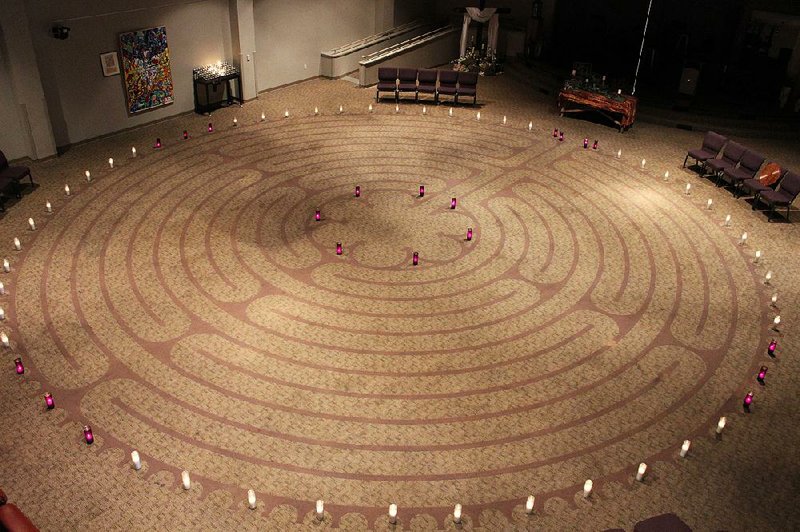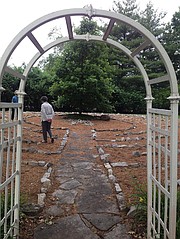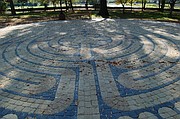Cristine Slikker went about the careful task of lighting candles Wednesday morning in a multipurpose room of Pulaski Heights United Methodist Church.
Incorporated into the design of the room's carpet is the shape of a labyrinth, the spiritual tool used for meditation and prayer while in motion. The structure is usually, but not always, circular and always contains one circuitous path that leads into and away from its center.
Instead of the 10 or so candles that are usually used, Slikker placed dozens around the labyrinth's perimeter.
"I really have trouble being quiet and focusing," said Slikker, a member of the church's labyrinth guild. "I couldn't quiet myself when I was introduced to the labyrinth. You have to look down to see where you're walking, because you turn left, you turn left, you turn right. You have to stay focused.
"By the time I get into the center [of the labyrinth], I'm able to put all the stuff you bring with you every day [and] put that aside. So it's a physical way of praying."
With the overhead lighting dimmed, the labyrinth was ready for visitors, along with other houses of worship across the globe this week that will observe World Labyrinth Day.
THEY ARE NOT MAZES
Labyrinths have winding paths that lead to its center and then outward again, but are not mazes. Some of the earliest examples date back approximately 4,000 years. Many are carved in stone or outlined with rocks, but others are made of canvas, shrubbery or created from mowing patterns in grass. The four-quadrant circular labyrinth is one of the most common formats and follows the layout of one of the best-known labyrinths at Chartres Cathedral in France.
Twylla Alexander, a Veriditas-certified labyrinth facilitator and author of the book Labyrinth Journeys: 50 States, 51 Stories, noted there has been a resurgence of interest in labyrinths in the past 25 years that took shape after the Rev. Lauren Artress, Canon of Grace Cathedral in San Francisco, rediscovered the labyrinth at Chartres and brought the concept back to San Francisco, installing one in the cathedral.
The labyrinth doesn't have to be used in prayer, Alexander said, "but we do find quite a few in churches because it is a meditative tool."
Alexander will facilitate today at 1 p.m. at the World Labyrinth Day walk at Hendrix College in Conway.
The Rev. J.J. Whitney, the chaplain at Hendrix, said the project came about after a student proposed creating one for his Odyssey project, one of three experiential projects students at the college are required to complete before graduating. The stone labyrinth is behind the college's Trieschmann Fine Arts building and near the grave of area civic leader Capt. W.W. Martin, and Whitney said it's still used often.
"There's very little in our lives these days for quiet time and reflection," Whitney said. "Regardless of [whether] you have a faith tradition or not, we all need that quiet time in our lives, and so we're grateful that we have a literal place carved out for that on campus."
The Rev. Susan Sims Smith, an Episcopal priest and executive director of the Interfaith Center, said the labyrinth is an archetype, a universal pattern that elicits certain human experiences.
A PHYSICAL PROCESS
Smith said what makes the labyrinth interesting is that experiencing it is a physical process, and although one can't get stuck in a labyrinth -- they don't contain dead ends -- the brain nevertheless gets confused.
"Your brain thinks about it like we think," Sims Smith said. "'If I'm a good girl and I just walk the straight and narrow, I'm going to go where I need to go.' But we all know that life doesn't actually work that way. There are times when you are taken toward the sacred center and you get almost there, and the path takes you way back out.
"The labyrinth carries you in its own archetypal, physiological, powerful way through a process where if you start into the labyrinth and you are worrying about something, the physiology of walking in the lab makes it difficult to worry."
Sims Smith will be part of the interfaith event "Walking the Sacred Path" on Sunday at the outdoor labyrinth of St. Margaret's, and will be part of an interfaith group that introduces participants to the workshop and presents it from Christian, Muslim and Jewish perspectives.
She will be joined by faith leaders including retired Supreme Court justice Annabelle Imber Tuck, who is Jewish. Tuck recently returned to Arkansas from a retreat at the Reform Judaism congregation of Shaare Emeth in St. Louis, which has a labyrinth with a chai, meaning "life" in Hebrew, and a tree in its center that is considered the Tree of Life -- a symbol in Kabbalah, a body of teachings in Judaism that deals with the essence of God.
The roots of the labyrinth didn't appear in Jewish texts until medieval times, Tuck said.
"In the Book of Joshua, it's all about Jericho," said Tuck, referring to the city that was believed to be the entry to the Promised Land.
A part of the book relates the tale of Joshua's command that the Ark of the Covenant circle the city seven times, blowing horns and shouting on the seventh circuit, and the walls would come down. Another verse mentioned the conquering of seven tribes.
Tuck said despite the differences between the Christian and Jewish faiths' approaches to interpreting the labyrinth, both view it as a symbol of obstacles.
THE WEDNESDAY BEFORE
World Labyrinth Day falls on the first Saturday in May each year, but the room at Pulaski Heights isn't always available on the specific day and Slikker said the church has taken to observing the special occasion the Wednesday before.
For those unable to walk the labryinth, the church also has two wooden, hand-held labyrinths that can be traced with a finger.
"We've had classes on meditation and other forms of praying methods," Slikker said. "As soon as I walked the labyrinth for the first time, I was like, 'Oh, this is going to work for me,' and it still does."
The labyrinth at Pulaski Heights United Methodist Church, 4823 Woodlawn Drive in Little Rock, is open each Wednesday from 8 a.m. to 8 p.m. The labyrinth at Hendrix College, 1600 Washington Ave. in Conway, is located behind the Trieschmann Fine Arts building. Tickets to "Walking the Sacred Path" are $20 at tinyurl.com/y429kt6b. Proceeds benefit the Arkansas House of Prayer. More information can be found at veritidas.org and labyrinthsociety.org/world-labyrinth-day. Individual labyrinths are listed at labyrinthlocator.com.
Religion on 05/04/2019


